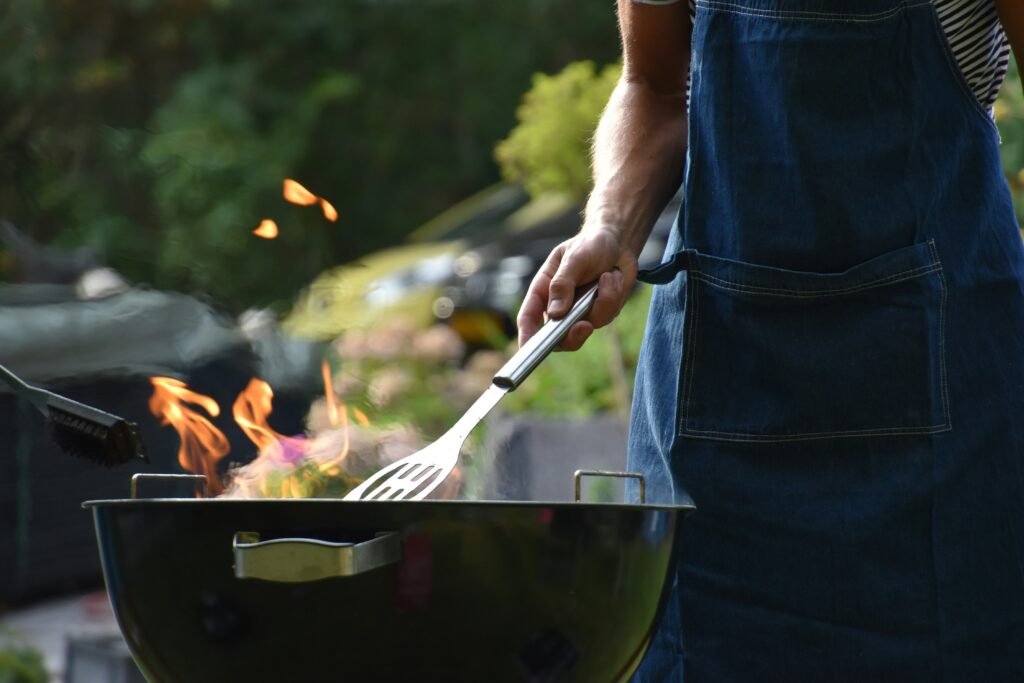When it comes to finding the perfect barbeque grill, you want to ensure that you’re making a well-informed decision. With so many options available, understanding the key features to look for can make all the difference in creating the ultimate backyard grilling experience. From heat distribution to size and cooking surface, we’ll explore the essential elements that will help you find the grill that suits your needs and elevates your outdoor cooking game. So, get ready to sizzle and make your next barbeque a memorable one!

Type of Grill
Charcoal grills
Charcoal grills are beloved by many for their traditional grilling experience. They use charcoal briquettes or natural wood as fuel, giving your food that distinct smoky flavor that is hard to replicate with other types of grills. Charcoal grills are great for outdoor enthusiasts who enjoy the process of preparing the grill and taking their time to cook their food to perfection. However, they require a bit more effort to light and maintain the charcoal fire.
Gas grills
Gas grills are popular for their convenience and ease of use. They run on propane or natural gas, allowing you to quickly start grilling without the need to wait for charcoal to heat up. Gas grills offer excellent heat control and temperature consistency, making them a top choice for those who want precise cooking results. They are also relatively easy to clean, with minimal ash or residue to deal with. Gas grills are ideal for individuals who prioritize convenience and efficiency in their grilling experience.
Electric grills
Electric grills provide a hassle-free option for those living in apartments or areas where open flame grilling may not be allowed. These grills are powered by electricity and can be used indoors or in compact outdoor spaces. They heat up quickly and offer consistent temperature control, making them suitable for quick grilling sessions. Electric grills are also easy to clean, as they do not produce any ash or smoke. If you’re looking for a convenient and versatile option, electric grills might be the right choice for you.
Portable grills
For the avid traveler or camper, portable grills offer the ultimate grilling on-the-go experience. These compact grills are designed to be lightweight and easy to transport, making them perfect for tailgating, picnics, or camping trips. Portable grills come in various fuel types, including charcoal, gas, and electric, giving you options to suit your preferences. They may have smaller cooking surfaces compared to larger grills, but they still pack a punch when it comes to flavor and functionality. If you enjoy outdoor adventures and want to savor the taste of grilled food anywhere you go, a portable grill is a must-have.
Size of the Grill
Small grills
Small grills are ideal for individuals with limited outdoor space or those who typically cook for a small group of people. These grills are compact and can easily fit on balconies, patios, or small yards. They often have a cooking surface area of around 200 to 300 square inches, which is enough to grill a few burgers or steaks at a time. Small grills are also great for those who prioritize portability and want a grill that they can easily move around.
Medium grills
Medium grills strike a balance between size and cooking capacity. They offer a larger cooking surface area, typically ranging from 300 to 500 square inches, allowing you to grill a decent amount of food at once. Medium grills are suitable for average-sized families or gatherings where you need to cook for a moderate number of people. They are also versatile enough to handle different types of food, from burgers and hot dogs to larger cuts of meat or vegetables.
Large grills
If you often host big backyard parties or cookouts, a large grill should be your go-to choice. These grills are designed for those who need to cater to a large crowd. With a cooking surface area of over 500 square inches, you can easily cook multiple dishes simultaneously. Large grills often come with additional features such as side burners, storage areas, and warming racks to enhance your grilling experience. While they may require more space, their versatility and ability to handle large quantities of food make them worth considering for avid grillers and entertainers.
Material
Stainless Steel grills
Stainless steel grills are known for their durability and resistance to rust and corrosion. They are easy to maintain and clean, making them a popular choice among grill enthusiasts. Stainless steel grills also provide even heat distribution, ensuring consistent cooking results across the entire cooking surface. They are relatively lightweight, making them easier to maneuver and transport. If you’re looking for a long-lasting grill that can withstand the test of time, a stainless steel grill is an excellent option.
Cast Iron grills
Cast iron grills are renowned for their ability to retain and distribute heat efficiently. They offer excellent heat retention, which helps in achieving those beautiful sear marks on your steaks or burgers. Cast iron grills can handle high heat, making them perfect for achieving the desired charred flavor. However, they require more maintenance compared to other materials, as they are prone to rust if not properly cared for. Regular seasoning and cleaning are necessary to keep cast iron grills in top condition.
Ceramic grills
Ceramic grills, also known as kamado grills, have gained popularity in recent years. These grills are made from thick ceramic material, which helps in retaining heat and moisture, resulting in juicy and flavorful food. Ceramic grills are incredibly versatile, allowing you to grill, smoke, and even bake with them. They offer excellent temperature control, allowing you to maintain low and slow cooking for hours. While they tend to be more expensive, ceramic grills are highly sought after by serious grillers who prioritize quality and versatility.
Grill Grates
Coated cast iron
Coated cast iron grates provide the durability and heat retention of cast iron with the added benefit of a non-stick cooking surface. The coating helps prevent food from sticking and makes it easier to clean. Coated cast iron grates often require seasoning to maintain their non-stick properties, but they are valued for their ability to create those beautiful grill marks on your food.
Stainless steel
Stainless steel grates are known for their durability and resistance to rust. They are easy to clean and maintain, making them a popular choice for many grillers. Stainless steel grates offer excellent heat distribution, ensuring even cooking across the entire surface. However, they do not retain heat as well as cast iron, which may result in slightly longer cooking times.
Porcelain enameled
Porcelain enameled grates combine the durability of stainless steel with the non-stick properties of enamel coating. These grates are easy to clean, as the enamel prevents food from sticking. They also offer excellent heat retention and distribution, allowing for consistent cooking results. However, porcelain enameled grates can chip or scratch over time if not handled with care.

Heat Distribution
Uniform heat distribution
Uniform heat distribution is an essential factor to consider when choosing a grill. It ensures that your food cooks evenly, preventing hot spots or undercooked portions. Gas grills are known for their ability to provide consistent heat distribution, thanks to the burner design that spreads the flame evenly across the cooking surface. Stainless steel and ceramic grills also excel in maintaining uniform heat, ensuring that every bite is cooked to perfection.
Hot spots and cool zones
Some grills may have areas that are hotter or cooler than others due to design or fuel type. While this may not always be a disadvantage, it’s important to be aware of these hot spots and cool zones to adjust your cooking technique accordingly. If you’re cooking different types of food simultaneously, you can utilize these temperature variations to your advantage. However, if your grill has significant hot spots, it may require more attention and adjustments during the cooking process.
Temperature Control
Adjustable venting systems
Charcoal and ceramic grills often feature adjustable venting systems that allow you to control the airflow and, therefore, the temperature. By adjusting the vents, you can increase or decrease the heat intensity, giving you more control over the cooking process. This feature is particularly useful for achieving low and slow cooking or searing at high temperatures.
Thermostats and temperature gauges
Gas and electric grills typically come with built-in thermostats or temperature gauges to help you monitor the cooking temperature accurately. These features allow you to set and maintain your desired cooking temperature with ease. Having precise temperature control ensures consistent results and eliminates the need for guesswork.

Safety Features
Stable construction
A grill with stable construction is essential for safe and worry-free grilling. Look for grills that have sturdy legs, a solid base, and a well-built frame to prevent accidental tip-overs. The stability of the grill ensures that it remains steady and secure during the grilling process, reducing the risk of accidents or injuries.
Heat resistant handles
Heat resistant handles are crucial for safe grilling, as they allow you to handle the grill and its components without the risk of burns. Look for grills that have handles made from high-quality heat-resistant materials, such as stainless steel or heat-resistant plastic, to ensure your safety while grilling.
Lid locks
Lid locks are an important safety feature that prevents the grill’s lid from accidentally opening or closing during the cooking process. They help maintain a consistent temperature inside the grill and prevent any potential mishaps or injuries. Lid locks ensure that the lid remains securely in place, giving you peace of mind while grilling.
Additional Features
Side burners
Some grills come equipped with side burners, which are additional cooking surfaces located next to the main grill. Side burners provide extra cooking space, allowing you to prepare side dishes, sauces, or even boil water without the need for a separate stove. This convenient feature saves you time and effort by keeping all your cooking in one place.
Storage and prep areas
Grills with built-in storage and prep areas offer added convenience during your grilling sessions. These features often include shelves, drawers, or cabinets for storing utensils, plates, and other grilling accessories. Having everything you need within easy reach enhances your grilling experience and keeps your cooking area organized.
Warming racks
Warming racks are a valuable addition to any grill, as they allow you to keep cooked food warm without overcooking it. These racks are typically located above the main cooking surface and provide a space to place finished food while you continue grilling. Warming racks are especially useful when cooking multiple dishes or when you need to serve food over an extended period.
Rotisserie burners
Grills with rotisserie burners offer a whole new level of cooking versatility. The rotisserie burner, usually located at the back of the grill, allows you to skewer and rotate large cuts of meat, such as whole chickens or roasts, for slow and even cooking. This feature helps to achieve tender and juicy results that are difficult to replicate with other cooking methods.
Price Range
Budget grills
Budget grills offer an affordable option for those looking to enter the grilling world without breaking the bank. These grills often come with basic features and may be smaller in size, but they can still deliver satisfactory grilling results. While they may lack some of the advanced features found in higher-end models, budget grills are a great starting point for beginners or occasional grillers.
Midrange grills
Midrange grills strike a balance between affordability and functionality. They offer a wider range of features, sizes, and materials to choose from, catering to a broader range of grilling needs. Midrange grills often have better construction, more powerful burners, and additional cooking space compared to budget grills. They provide a good balance of quality and price, making them suitable for both casual grillers and more experienced cooks.
High-end grills
High-end grills are the pinnacle of grilling excellence. They often boast top-notch construction, superior materials, and advanced features that enhance the grilling experience. These grills offer the ultimate in temperature control, durability, and performance. High-end grills are for serious grill enthusiasts who want nothing but the best and are willing to invest in a grill that will last for years.
Warranty and Support
Warranty period
When purchasing a grill, it’s essential to consider the warranty period offered by the manufacturer. A longer warranty period gives you peace of mind, knowing that the manufacturer stands behind their product. Look for grills with warranties that cover major components such as burners, grates, and other essential parts. A generous warranty period often indicates the manufacturer’s confidence in the quality and durability of their product.
Customer support and services
Good customer support and services are crucial, especially when it comes to troubleshooting or addressing any technical issues with your grill. Choose a brand that is known for their prompt and helpful customer service. This ensures that you have reliable assistance whenever you encounter any problems or have questions regarding your grill.
Availability of spare parts
The availability of spare parts is an often overlooked but important aspect to consider. Over time, certain components of your grill may wear out or require replacement. Ensuring that spare parts are readily available for your chosen grill brand can save you from the frustration of not being able to find the right parts when needed. It also extends the lifespan of your grill by allowing for easy repairs and maintenance.
In conclusion, when it comes to choosing a barbeque grill, several key features warrant consideration. The type of grill, size, and material will greatly impact your grilling experience and the flavor of your food. Grill grates, heat distribution, and temperature control are pivotal to achieving perfectly cooked meals. Safety features, additional functionalities, and price range determine the convenience and versatility of a grill. Lastly, warranty, customer support, and availability of spare parts ensure the peace of mind and longevity of your investment. By carefully examining these features, you can select the perfect grill that suits your needs, preferences, and budget. So get ready to fire up your new grill and enjoy endless outdoor cooking adventures!

